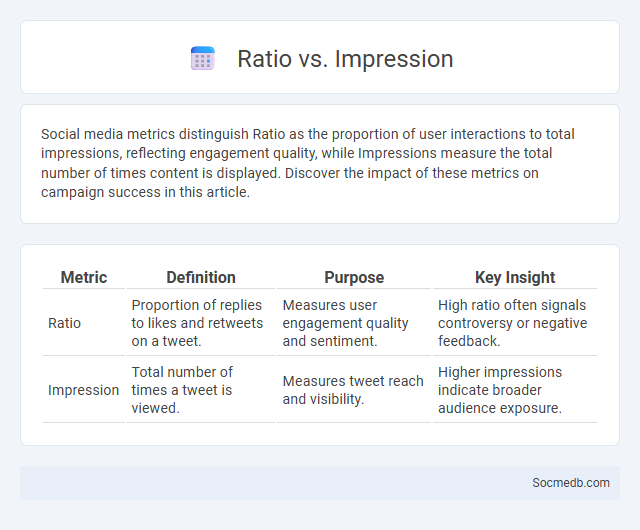
Photo illustration: Ratio vs Impression
Social media metrics distinguish Ratio as the proportion of user interactions to total impressions, reflecting engagement quality, while Impressions measure the total number of times content is displayed. Discover the impact of these metrics on campaign success in this article.
Table of Comparison
| Metric | Definition | Purpose | Key Insight |
|---|---|---|---|
| Ratio | Proportion of replies to likes and retweets on a tweet. | Measures user engagement quality and sentiment. | High ratio often signals controversy or negative feedback. |
| Impression | Total number of times a tweet is viewed. | Measures tweet reach and visibility. | Higher impressions indicate broader audience exposure. |
Understanding Ratios in Digital Metrics
Understanding ratios in digital metrics such as engagement rate, click-through rate (CTR), and conversion rate is crucial for analyzing social media performance. Engagement rate measures interactions like likes, comments, and shares relative to total followers, providing insights into audience responsiveness. CTR evaluates the percentage of users who click on a posted link, helping to assess content effectiveness and drive targeted actions.
What Are Impressions and Why Do They Matter?
Impressions on social media represent the total number of times a post or advertisement is displayed to users, regardless of engagement. They matter because high impression counts indicate content visibility and brand awareness, which are crucial for measuring the reach of marketing campaigns. Tracking impressions helps businesses optimize strategies to increase audience exposure and improve overall digital presence.
The Role of Engagement Ratios in Social Media
Engagement ratios on social media measure the interaction between your audience and content, including likes, comments, shares, and clicks relative to your follower count. Higher engagement ratios indicate stronger community connections and more effective content strategies, which boost brand visibility and trust. Monitoring and optimizing these metrics helps you tailor your posts to increase user interaction and drive meaningful growth.
Impression vs Ratio: Key Differences
Impression measures the total number of times your content is displayed, while the ratio typically compares impressions to other metrics such as clicks or engagements, indicating the effectiveness of your posts. Understanding the difference between impression count and engagement ratio helps you optimize your social media strategy by highlighting how often users see your content versus how many interact with it. Tracking these metrics ensures you can accurately assess your content's reach and user response on various platforms.
How to Calculate and Interpret Ratios
To calculate and interpret social media ratios such as engagement rate, divide the total interactions (likes, comments, shares) by the total followers and multiply by 100 to get a percentage reflecting audience engagement. Your follower growth rate can be determined by subtracting the previous follower count from the current count, dividing by the previous count, and multiplying by 100 to reveal how quickly your audience is expanding. Analyzing these ratios provides insights into your content's effectiveness and helps tailor strategies for maximizing reach and audience interaction.
Impressions: Quantity vs. Quality
Impressions measure the total number of times your content is displayed, but high quantity does not always translate to meaningful engagement or conversions. Focusing on quality impressions--those from your target audience--ensures better interaction and higher return on investment. Optimizing content for relevance and timing significantly enhances the impact of your social media impressions.
When to Prioritize Ratio Over Impressions
Prioritize ratio over impressions when engagement and audience interaction matter more than reach, such as during product launches or community building efforts. High-quality engagement metrics like click-through rate, comments, and shares indicate how well Your content resonates with your target audience. Focusing on ratio ensures that Your social media strategy drives meaningful connections rather than just broad visibility.
Common Mistakes in Interpreting Impressions and Ratios
Misinterpreting social media impressions often leads to overestimating your content's reach, as impressions count all views whether from unique users or repeat visits. Focusing solely on high impression-to-engagement ratios can misrepresent audience quality, ignoring factors like bot activity or irrelevant impressions. Your analysis should incorporate context and cross-reference multiple metrics to avoid skewed conclusions about campaign effectiveness.
Case Studies: Ratio vs Impression in Real Campaigns
Analyzing case studies on Ratio vs Impression in real social media campaigns reveals that a higher engagement ratio often drives more meaningful audience interactions than sheer impression volume. Your campaign's success improves when optimizing content for engagement rates, as demonstrated by brands that prioritize click-throughs and shares over broad but passive reach. Metrics from top-performing campaigns underscore the value of quality interactions, proving ratio outperforms raw impressions in generating solid ROI.
Optimizing Strategies: Balancing Impressions and Ratios
Optimizing social media strategies requires carefully balancing impressions with engagement ratios to maximize Your content's reach and effectiveness. Tracking metrics like click-through rates (CTR), engagement rates, and impression-to-action ratios helps identify which posts resonate most with Your audience. Leveraging these insights allows You to fine-tune content timing, formats, and targeting for sustained growth and improved ROI.
 socmedb.com
socmedb.com